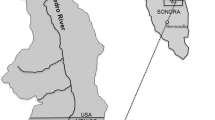Abstract
Temporal and spatial variability of particulate metal concentrations (Cu, Cr, Zn, Mn and Fe) were investigated in the lower drainage basin of the Paraíba do Sul River. The results showed that the spatial variability was not important for all the studied metals, however, temporal variations seems to be considerable. In general, two distinct behaviors were observed for particulate heavy metals: (1) metal concentration increase together with water flow (Fe and Cu) and (2) concentration decrease with increasing water flux (Zn, Cr and Mn). The Fe and Cu behavior is probably due to the strong association of these metals with surface runoff, although their sources seem to be distinct. Iron probably originates from the regional soils rich in iron oxides, and Cu is possibly associated to the large-scale use of copper fungicides in the sugar cane plantations. The opposite trend observed for Zn, Cr and Mn probably reflects the importance of the industrial and urban effluents as a secondary source of these elements for the system. Their behavior is probably associated with the dilution effect caused by the input of a suspended matter poor in these metals originated from the surface runoff during the rainy season.
Similar content being viewed by others
Author information
Authors and Affiliations
Additional information
Received: 4 March 1998 · Accepted: 30 June 1998
Rights and permissions
About this article
Cite this article
Carvalho, C., Ovalle, A., Rezende, C. et al. Seasonal variation of particulate heavy metals in the Lower Paraíba do Sul River, R.J., Brazil. Environmental Geology 37, 297–302 (1999). https://doi.org/10.1007/s002540050387
Issue Date:
DOI: https://doi.org/10.1007/s002540050387




